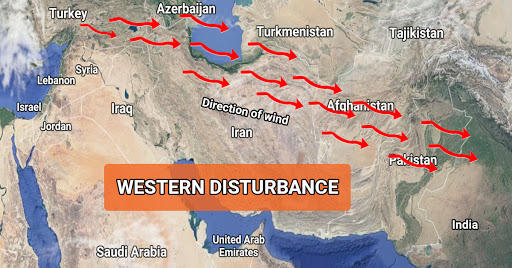Unusual Behavior of Western Disturbances in India
In recent years, western disturbances, cyclonic storms originating from the Mediterranean region, have been exhibiting unusual behavior in India.
Unusual Behavior and Lengthy Journey
Western disturbances have been displaying unusual behavior in India for at least three years. These cyclonic storms travel an astonishing distance of over 9,000 km to bring winter rains to northwest India. However, since 2019, winter rainfall across the country has witnessed a predominantly dry trend, leading to concerns for the agricultural sector.
The Anomalous May
May 2023 was a notable month for northern India as it experienced intense rainfall along with below-normal temperatures. The region received 175% more rainfall than normal, contributing to a unique climatic scenario. The deviation in weather patterns during this month primarily impacted rabi crops, particularly the harvest and marketing of wheat grains, resulting in losses for farmers.
Examining Western Disturbances in Solan
Researchers at Dr Y S Parmar University of Horticulture & Forestry in Solan, Himachal Pradesh, have studied the behavior of western disturbances in the region. Their analysis spanning five decades reveals significant changes in the duration and onset of these weather events.
Changing Duration and Onset
Between 1971 and 2021, the average duration of a western disturbance in Solan, which typically lasts for 139 days from October to May, has been decreasing at a rate of 0.29 days per year. Additionally, the onset of these disturbances has advanced by 0.19 days per year, while their withdrawal has been delayed by 0.11 days per year. These alterations in timing have notable consequences for agricultural practices in regions dependent on rainfall.
Impact on Crop Sowing and Harvesting
The changing onset and withdrawal of western disturbances have a direct impact on crop sowing and harvesting. Variations in the timing of these weather events can lead to irregularities in crop sowing, delayed harvests, and increased vulnerability to excess rainfall. This especially affects regions lacking irrigation facilities and relying heavily on rainfall for agricultural activities.
Insights from Other Studies
Similar trends have been observed in other parts of India. A study by scientists from Punjab Agricultural University noted a lower number of western disturbances in November and a higher number in May in Punjab. These findings emphasize the need for further investigation into the evolving behavior of these weather systems.
Month: Current Affairs - June, 2023
Category: Environment Current Affairs • India Nation & States Current Affairs








